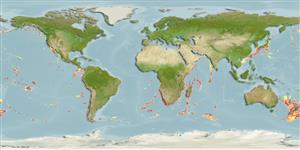Holocephali (quimeras) (chimaeras) >
Chimaeriformes (Chimaeras) >
Rhinochimaeridae (Longnose chimaeras)
Etymology: Rhinochimaera: A chimaera with rhinos (Gr.), nose, referring to long, pointed proboscis of R. pacifica (See ETYFish); africana: ana- (L.), belonging to: named for both its distribution around southern Africa and for the Sea Fisheries Research Institute research vessel Africana, from which holotype was collected (See ETYFish).
Environment: milieu / climate zone / depth range / distribution range
Ecologia
marinhas batidemersal; intervalo de profundidade 549 - 1450 m (Ref. 11228). Deep-water
Southeast Atlantic: southern Africa and Mozambique Channel. Pacific Ocean: Japan (off Hokkaido and northern Honshu) to the east China Sea, including Taiwan; Costa Rica and Peru.
Tamanho / Peso / Idade
Maturity: Lm ? range ? - ? cm
Max length : 81.8 cm TL macho/indeterminado; (Ref. 97389)
Descrição breve
Chaves de identificação | Morfologia | Morfometria
This species is distinguished by the following characters: elongate body with an elongate, broad and paddle-shaped pointed snout extending anterior to head (SNL 47.7% HDL), tapering to a slender tail; the junction of supraorbital and infraorbital canals on ventral side of snout is closer to the tip of the snout than to the nasal canal; ONC/TIO is greater than 1.4 (ONC/TIO= 1.64); TIO/SWF is less than 1.5 (TIO/SWF= 1.47); TIO/LNC is less than 3.0 (TIO/LNC= 2.75); tooth-plates are nearly smooth; eyes are relatively small (EYL 6.4% BDL), distinctly behind level of mouth; the first and second dorsal fins are separated by a relatively long interdorsal space (IDS 23.6% BDL) and not connected by a web of skin; caudal-fin axis weakly raised with the fin asymmetrical, the epaxial caudal-fin lobe narrower than hypaxial lobe; dorsal caudal tubercles 25; caudal filament vestigial; coloration uniformly dark brown across entire body, except the oronasal region which is abruptly paler than the body (Ref. 97389).
Rare (Ref. 11228). Oviparous (Ref. 205). Eggs are encased in horny shells (Ref. 205).
Life cycle and mating behavior
Maturidade | Reprodução | Desova | Ovos | Fecundidade | Larvas
Heemstra, P.C., 1995. Additions and corrections for the 1995 impression. p. v-xv. In M.M. Smith and P.C. Heemstra (eds.) Revised Edition of Smiths' Sea Fishes. Springer-Verlag, Berlin. (Ref. 11228)
Categoria na Lista Vermelha da IUCN (Ref. 130435: Version 2024-2)
Ameaça para o homem
Harmless
Utilização humana
Ferramentas
Relatórios especiais
Descarregue XML
Fontes da internet
Estimates based on models
Preferred temperature (Ref.
123201): 2.1 - 8.2, mean 5.5 °C (based on 195 cells).
Phylogenetic diversity index (Ref.
82804): PD
50 = 0.6289 [Uniqueness, from 0.5 = low to 2.0 = high].
Bayesian length-weight: a=0.00195 (0.00085 - 0.00449), b=3.14 (2.94 - 3.34), in cm total length, based on LWR estimates for this (Sub)family-body shape (Ref.
93245).
Nível Trófico (Ref.
69278): 3.8 ±0.5 se; based on size and trophs of closest relatives
Resiliência (Ref.
120179): Baixo, tempo mínimo de duplicação da população 4,5 - 14 anos (Assuming Fec <100).
Fishing Vulnerability (Ref.
59153): Moderate to high vulnerability (53 of 100).
